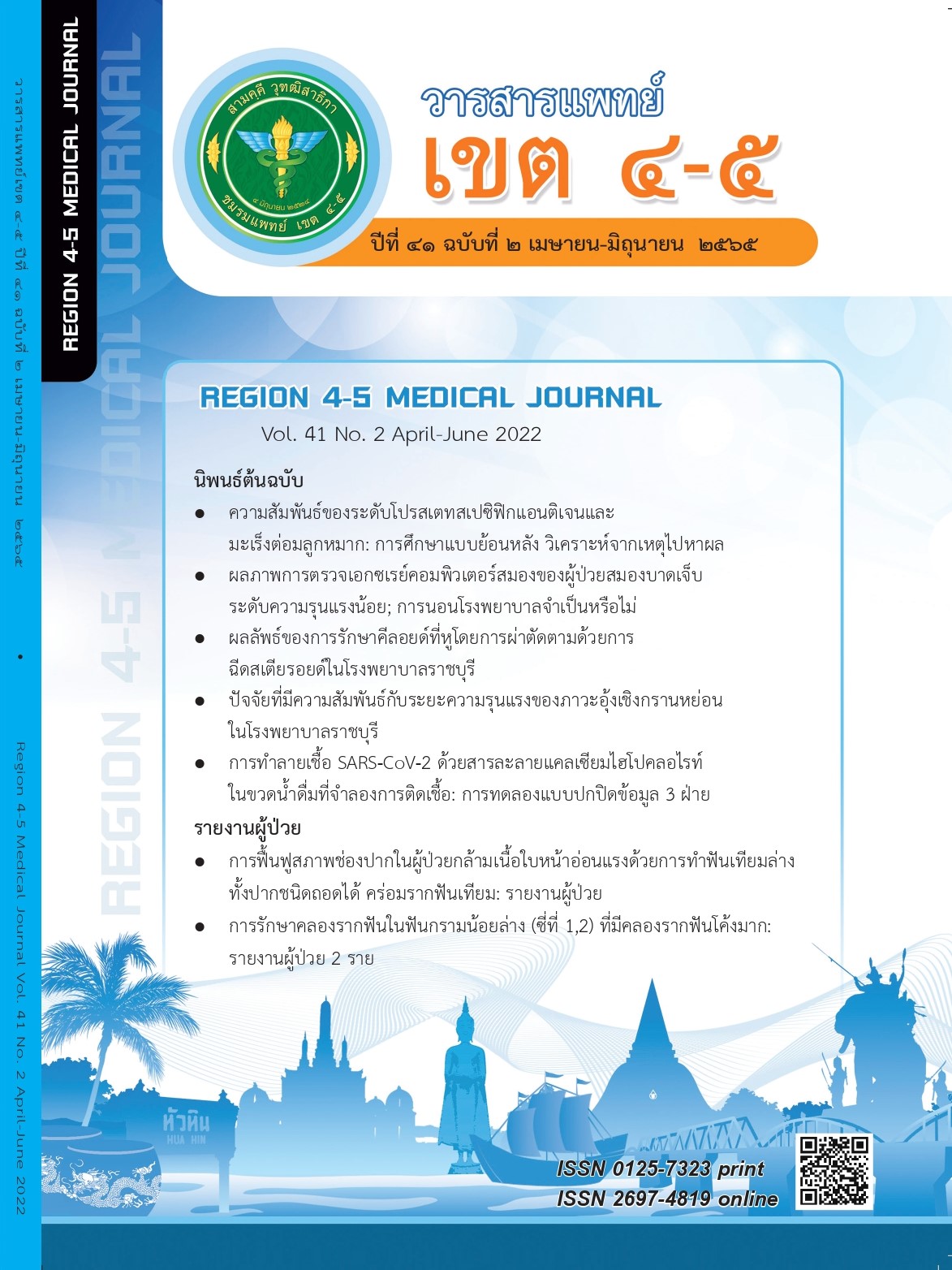ความสัมพันธ์ของระดับโปรสเตทสเปซิฟิกแอนติเจนและมะเร็งต่อมลูกหมาก : การศึกษาแบบย้อนหลัง วิเคราะห์จากเหตุไปหาผล
คำสำคัญ:
โปรสเตทสเปซิฟิกแอนติเจน, มะเร็งต่อมลูกหมาก, อัตราการตรวจพบมะเร็งต่อมลูกหมากบทคัดย่อ
วัตถุประสงค์: ต้องการหาความสัมพันธ์ของระดับโปรสเตทสเปซิฟิกแอนติเจน (Prostate-Specific Antigen : PSA) เปรียบเทียบกับอัตราการตรวจพบมะเร็งต่อมลูกหมากตามช่วง PSA ที่ต่างกัน
วิธีการศึกษา: ศึกษาเวชระเบียนของผู้ป่วยต่อมลูกหมากโตที่เข้ารับการรักษาที่ในโรงพยาบาลเจ้าพระยายมราชย้อนหลัง 5 ปี ตั้งแต่ 1 มกราคม 2559 ถึง 31 ธันวาคม 2563 ที่ได้รับการเจาะเลือดตรวจ PSA และมีค่าตั้งแต่ 4 นาโนกรัม/ มิลลิลิตร (ng/ml) ขึ้นไป และได้ทำการเจาะชิ้นเนื้อต่อมลูกหมากผ่านทางทวารหนัก แบ่งผู้ป่วยออกเป็น 3 กลุ่มตามระดับ PSA กลุ่มที่ 1 ระดับ PSA ตั้งแต่ 4-9.9 ng/ml กลุ่มที่ 2 ระดับ PSA ตั้งแต่ 10-19.9 ng/ml และกลุ่มที่ 3 ระดับ PSA ตั้งแต่ 20 ng/ml ขึ้นไป เพื่อคำนวณหาอัตราการตรวจพบมะเร็งต่อมลูกหมากตามช่วง PSA ที่ต่างกัน
ผลการศึกษา: ผู้ป่วยได้ทั้งหมด 413 ราย อายุเฉลี่ยของผู้ป่วย 68.49 ปี (ค่าเบี่ยงเบนมาตรฐาน 7.71) ค่า PSA เฉลี่ย 53.24 ng/ml (ค่าเบี่ยงเบนมาตรฐาน 159.57, ค่าต่ำสุด 4 ng/ml, ค่าสูงสุด 1,648 ng/ml) อัตราการตรวจพบมะเร็งต่อมลูกหมากจากผู้ป่วยทั้งหมดคิดเป็นร้อยละ 30.5 อัตราการตรวจพบมะเร็งต่อมลูกหมากเพิ่มขึ้นอย่างมีนัยสำคัญทางสถิติตามอายุที่มากขึ้น และตามค่า PSA ที่สูงขึ้น พบอัตราการตรวจพบมะเร็งต่อมลูกหมากร้อยละ 21.7, ร้อยละ 25.1, และร้อยละ 39.8 ในกลุ่มอายุ 50-60 ปี, 61-70 ปี, และ กลุ่มอายุมากกว่า 70 ปี ตามลำดับ (p < .01) พบอัตราการตรวจพบมะเร็งต่อมลูกหมากร้อยละ 11.7, ร้อยละ 21.2, และร้อยละ 73.8 ในช่วง PSA 4-9.9 ng/ml , 10-19.9 ng/ml , และ PSA ตั้งแต่ 20 ng/ml ขึ้นไป ตามลำดับ (p < .01) ผลแทรกซ้อนหลังการตรวจชิ้นเนื้อต่อมลูกหมากทางทวารหนักพบผู้ป่วยมีไข้สูงติดเชื้อทางเดินปัสสาวะ 14 คน (ร้อยละ 3.3), ปัสสาวะเป็นเลือด 5 คน (ร้อยละ 1.2), ปัสสาวะไม่ออก 13 คน (ร้อยละ 3.2) ไม่มีผลแทรกซ้อน 381 ราย (ร้อยละ 92.3)
สรุป: อัตราการตรวจพบมะเร็งต่อมลูกหมากจากผู้ป่วยทั้งหมดที่ได้รับการเจาะเลือดตรวจ PSA และมีค่าตั้งแต่ 4 นาโนกรัม/มิลลิลิตรขึ้นไป คิดเป็นร้อยละ 30.5 โดยอัตราการตรวจพบมะเร็งต่อมลูกหมากจะสูงขึ้นตามอายุที่มากขึ้น โดยสูงถึงร้อยละ 39.8 ในกลุ่มที่มีอายุมากกว่า 70 ปี และอัตราการตรวจพบมะเร็งต่อมลูกหมากเพิ่มสูงขึ้นตามค่า PSA ที่สูงขึ้น โดยเฉพาะถ้า PSA สูงกว่า 20 นาโนกรัม/ มิลลิลิตรมีอัตราการตรวจพบมะเร็งต่อมลูกหมากที่สูงถึง ร้อยละ 73.8
เอกสารอ้างอิง
Thompson IM, Pauler DK, Goodman PJ, et al. Prevalence of prostate cancer among men with a prostate-specific antigen level < or =4.0 ng per milliliter. N Engl J Med 2004;350(22):2239–46.
Virani S, Bilheem S, Chansaard W, et al. National and Subnational Population-Based Incidence of Cancer in Thailand: Assessing Cancers with the Highest Burdens. Cancers (Basel) 2017;9(8):108.
Siegel RL, Miller KD, Jemal A. Cancer statistics, 2020. CA Cancer J Clin 2020;70(1):7–30.
Khazaei, S. Rezaeian, S. Ayubi, et al. Global prostate cancer incidence and mortality rates according to the human development index. Asian Pac J Cancer Prev 2016;17(8):3791–94.
Sherman R, Firth R, De P, et al. Cancer In North America, 2012-2016. Vol 3. Registry-Specific Cancer Mortality in the United States and Canada. North American Association of Central Cancer Registries Inc; 2019.
Heidenreich A, Bastian PJ, Bellmunt J, et al. EAU guidelines on prostate cancer. Part 1: Screening, diagnosis, and local treatment with curative intent-update 2013. Eur Urol 2014;65:124–37.
Ilic D, Djulbegovic M, Jung J, et al.Prostate cancer screening with prostate-specific antigen (PSA) test: a systematic review and meta-analysis. BMJ 2018;362:k3519.
Hernández J, Thompson IM. Prostate-specific antigen: a review of the validation of the most commonly used cancer biomarker. Cancer 2004;101(5):894–904.
Yunusa B, Abdullahi M, Mashi SA, et al. Determination of the sensitivity and specificity of serum prostate-specific antigen in the diagnosis of prostrate cancer in Kano, Northwestern Nigeria. Niger J Basic Clin Sci 2017;14:88–91.
Amin MB, Edge S, Greene F, et al. AJCC Cancer Staging Manual (8th edition). Springer International Publishing: American Joint Commission on Cancer; 2017
Laddha A, Thomas A, Nair DC, et al. Outcomes of standard 12–core transrectal ultrasound-guided prostate biopsy in biopsy naive Indian men–single center experience. Indian J Urol 2020;36(3):179–83.
Albertsen PC. Prostate cancer screening with prostate-specific antigen: Where are we going?. Cancer 2018;124(3):453–55.
Janbaziroudsari H, Mirzaei A, Maleki N. Association of serum prostate-specific antigen levels with the results of the prostate needle biopsy. Bull Cancer 2016;103(9):730–4.
Sarıkaya S, Resorlu M, Oguz U, et al. Evaluation of the pathologic results of prostate biopsies in terms of age, Gleason score and PSA level: our experience and review of the literature. Arch Ital Urol Androl 2014;86(4):288–90.
Lotfi M, Beheshti R, Rouhezamin MR et al. A Ten–Year Study of Prostate Cancer: A Southern Iranian Experience. Iran J Med Sci 2018;43(4):372–9.
Efesoy O, Bozlu M, Çayan S, et al. Complications of transrectal ultrasound–guided 12–core prostate biopsy: a single center experience with 2049 patients. Turk J Urol 2013;39(1):6–11.
Rodríguez LV, Terris MK. Risks and complications of transrectal ultrasound guided prostate needle biopsy: a prospective study and review of the literature. J Urol 1998;160(6 Pt1):2115–20.
Stewart RW, Lizama S, Peairs K, et al. Screening for prostate cancer. Semin Oncol 2017;44(1):47–56.
ดาวน์โหลด
เผยแพร่แล้ว
รูปแบบการอ้างอิง
ฉบับ
ประเภทบทความ
สัญญาอนุญาต

อนุญาตภายใต้เงื่อนไข Creative Commons Attribution-NonCommercial-NoDerivatives 4.0 International License.
ลิขสิทธิ์บทความเป็นของผู้เขียนบทความ แต่หากผลงานของท่านได้รับการพิจารณาตีพิมพ์ลงวารสารแพทย์เขต 4-5 จะคงไว้ซึ่งสิทธิ์ในการตีพิมพ์ครั้งแรกด้วยเหตุที่บทความจะปรากฎในวารสารที่เข้าถึงได้ จึงอนุญาตให้นำบทความในวารสารไปใช้ประโยชน์ได้ในเชิงวิชาการโดยจำเป็นต้องมีการอ้างอิงถึงชื่อวารสารอย่างถูกต้อง แต่ไม่อนุญาตให้นำไปใช้ในเชิงพาณิชย์




